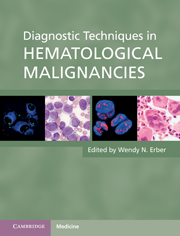2 - Immunocytochemistry
from Part 1 - Diagnostic techniques
Published online by Cambridge University Press: 06 December 2010
Summary
Immunocytochemistry, or immunohistochemistry, is the method by which antibodies are used to detect cellular antigens in clinical samples. This can be performed on all routine diagnostic samples, including blood and bone marrow smears and bone marrow trephine (BMT) biopsies, in the assessment of hematological malignancies. The methodology enables simultaneous assessment of antigen expression and cell morphology so that cells of interest can be identified by their appearance and their phenotype determined. The major role of immunocytochemistry is in the diagnosis and classification of hematological malignancies, but it also has applications in lymphoma staging, determining prognosis, detecting potential immuno-therapeutic targets and for disease monitoring. Immunocytochemistry is used routinely to determine the phenotype (lineage and stage of differentiation) of neoplastic cells and is essential for the classification of hematological malignancies according to WHO criteria. This chapter describes the principles and applications of immunocytochemistry in the analysis of hematological malignancies. It includes discussion of monoclonal antibodies, hematopoietic differentiation and technical considerations, and illustrates some applications with clinical examples.
Monoclonal antibodies
The majority of antibodies used in immunocytochemistry are monoclonal antibodies. These were first generated in 1975 by fusing an immortal myeloma cell line with splenic B-cells from an animal immunized with the desired antigen. The resulting hybridoma (or hybrid cell) produces antibodies with unique heavy and light chains and hence binding site. They are therefore clonal, have a single specificity and are termed “monoclonal” antibodies. Many thousands of monoclonal antibodies are available covering a wide range of cellular antigens.
- Type
- Chapter
- Information
- Diagnostic Techniques in Hematological Malignancies , pp. 28 - 50Publisher: Cambridge University PressPrint publication year: 2010
References
- 2
- Cited by



